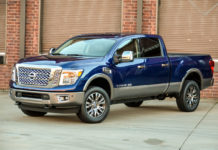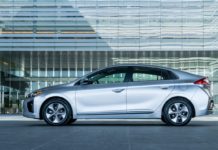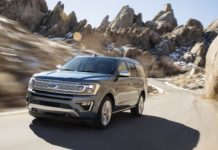The first Rolls-Royce convertible since the British marque was taken over by BMW five years ago is going on sale this summer.
Tuscany in spring makes no allowances for roaring, supercharged engines.
As the locals gear up for the annual invasion of British holidaymakers, it just wouldn't be cricket to buzz about these winding roads, disturbing the peace.
Fortunately, cruising leisurely between fortified Tuscan castellos in the Rolls-Royce Drophead Coupe is hardly more noisy than an Englishman in a hammock after lunch.
The point is hammered home as we gently glide to a halt in sleepy Bunconvento, where an old woman leisurely crosses the street.
“She probably can't hear us,” Rolls-Royce's communications director, Graham Biggs, almost whispers, clearly keen not to disturb the peace.
Turning heads
But although its 6.7 litre V12 engine is incredibly silent, the convertible is screaming wealth.
In the UK, where it will go on sale in July, the car will cost some £325,000 when extras such as chrome wheels (£4,500), a brushed steel bonnet (£6,400) and a teak deck (£5,300) around the back seats are included.
| Click to Enlarge
|
This makes it the perfect machine for cruising the boulevards of Europe's yachting centres, or for posing in Beverly Hills.
At least 40% of its customers will be recruited amongst America's super-rich – who will be paying some $500,000 before tax and extras for the car – though some 20,000 of the world's 85,400 ultra-high net worth individuals – people with more than $30m (£15m) ready cash at their disposal, as measured by CapGemini Merrill Lynch – are European, 3,700 of them British.
“The wealth factor is an important part of the market growth,” points out Rolls-Royce Motor Cars' chief executive, Ian Robertson.
“We're aiming to pick up about 1% of them each year.”
Tough performer
Turning the corner to take on one of the many steep, pine-covered hills leading up to Castello Banfi, and it soon becomes clear that the car itself is far from sleepy.
As this tank of a car takes Tuscany's S-bends in its stride, its tyres squeal like a banker losing his bonus, yet there is remarkably little roll.
The car is fast, for sure. On paper, it is said to race from standstill to 60mph in less than six seconds; a stat that is bound to impress the world's wealthy.
But it is not for speeding that the local police decide to pull me over a few moments later.
“We were just curious,” grins one of them, inadvertently pointing his machine gun directly at my unprotected temple, while the other one shuffles over to the back of the car.
“Perhaps it is the wrong car on these roads?” he suggests. “It is very big.”
Customer endorsement
Indeed, the cabriolet is bigger than most other things on the road; a tricky u-turn is not even attempted as I instead opt to go the long way around a roundabout.
Yet, through most other bends surrounding Castello di Velona, which clings to a hilltop, the car feels much smaller and more nimble than it actually is.
In terms of its impact on Rolls-Royce Motor Cars, however, the convertible could be huge.
Not only is it expected to bring in new, younger clients; it has also impressed the old guard.
“Fifty per cent of the current order-book is from existing Rolls-Royce Phantom owners,” Mr Robertson reveals.
“For most of them, it is an order for an additional car, not a replacement.”
Picky customers
This kind of endorsement from existing customers is exceptionally valuable for Rolls-Royce as it struggles to grow sales from its disappointing start five years ago.
Since then, sales have risen from just 300 cars in 2003, to more than 800 last year and heading higher.
“It would be fair to say we now understand our customers a lot better,” says Mr Robertson.
“At the moment, a lot of our buyers are entrepreneurs,” he explains.
Paradoxically, many a customer eager to whip the roof off his Roller became wealthy enough to buy one thanks to people's desire for a roof over their head.
“It's been in property in one form or another” where many of them have made their money, observes Mr Robertson.
“They are extremely focused on value for money. Within their peer group, they like to be seen to be making the right decisions.”
Special arrangements
In addition, a typical Rolls-Royce client is very busy and difficult to get close to.
“They have many people around them and they are impervious to what we'd call traditional marketing,” adds Mr Robertson.
Yet, they still like to be made to feel special, and this has allowed Rolls-Royce to get many a billionaire's attention.
“They like to be invited to small, bespoke arrangements in interesting places that are not freely available to the public,” says Mr Robertson, whose people spend much of their time dreaming up fresh events for the ultra-rich.
Not rivals
On average, Rolls-Royce's clients already own an average of seven or eight cars, along with three to five properties and in some instances a private jet (14%), or a yacht (7%).
On one level, this places Rolls-Royce in head-on competition with a string of companies outside the automotive sphere, yet it is hardly perceived as a threat.
“Perhaps they could buy one of our cheaper yachts for the price of a Rolls-Royce,” observes Daniele Bessone, spokesman for Italian yacht-maker Azimut-Benetti.
“But we don't see them as a competitor. If our customers would like a Rolls-Royce, they could afford to buy one in addition to one of our yachts.”
“We are not just competing for a share of their wealth, we are competing for their attention,” agrees Mr Robertson, who is certain there are enough customers to go around.
There are almost 6.5 billion people in the world, points out Mr Robertson. “We're only looking for 800 of them at the time.”








